The Planet Earth
Reading and Assessment
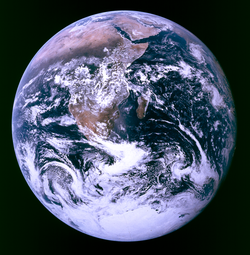 |
||
How far is the Earth to the sun?
The distance ranges between about 91 million miles and 94.5 million miles. Interestingly, the seasons do not depend on the distance of earth to sun, instead on the tilt of the earth.
How big is the Earth?
The Earth is nearly 13,000 kilometres (km) wide. It's the largest terrestrial planet in the Solar System.
The Earth weighs 5,973,700,000,000,000,000,000,000 kilograms (kg). That's nearly 6 trillion trillion kg. That's a lot. But it's little compared with Jupiter ({insert weight}) and tiny compared with the Sun ({insert weight}) or other stars!
What is its surface like?
Earth is the planet we live on. It is the only planet in the Solar System with liquid water on its surface. It is also the only planet we know to have life on it. The Earth is the only planet we know to have living things on it.
The Earth's surface is made of rock. Much of it is under water, but not all. Islands of rock rise up out of the water. The biggest islands we call continents, of which there are seven: North America, South America, Europe, Asia, Africa, Australia, and Antarctica. The biggest water we call oceans, of which there are four: Pacfic, Atlantic, Indian, and Arctic. Some authorities classify the Southern as a fifth ocean.

The Earth's surface is divided into huge plates. They are like huge jigsaw pieces made of rock. These plates move very very slowly, carrying the continents with them. They rub beside each other, or push against each other, or move away from each other. In the gaps between them, hot molten rock can rise up and make volcanoes. Where the plates rub or push against each other, earthquakes may happen. When two plates push each other's rock upwards, mountains are formed.

Earth has many kinds of environments. It is cold and icy in places like Antarctica. It is hot and dry in deserts like the Sahara in Africa and Death Valley in the United States. It is cold and dry in deserts like Siberia in Russia. Where it is warm and wet, rainforests grow.
Why is there life on Earth?
Wherever we have looked on Earth, we have found living things. They may be very small, like bacteria, but they are there. We have found bacteria where it is very cold, very hot, very deep, very high or very dark.
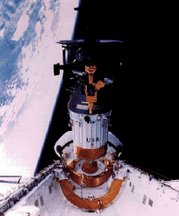
What all living things on Earth seem to need is liquid water. Wherever you can find some water, there are almost always living things there too, even if you can't see them. If we find liquid water somewhere else in the Solar System, scientists think we might find some living things there too. If we don't, there is always the rest of the universe to try!
There is another possibility. All the living things we know need water. But maybe somewhere else there are living things that don't need water. Perhaps we will need to learn how to recognise them.
What about the Earth's moon?
Earth has one moon we call... the Moon! Sometimes it is called Luna so we don't get confused with other planets and their moons. The Moon has also been called Selene (said "suh-LEE-nee").
Recently we have also found some other rocks going around the Earth. The largest one, called Cruithne (said "cru-EE-nyuh"), is three miles wide. It orbits (goes around) the Earth like a comet orbits the Sun.
How long is a day on this planet?
A day on Earth is 24 hours long. That's daytime and nighttime. That's how long it takes the Earth to spin around once.
How long is a year on this planet?
A year on Earth is 365 days long. That's how long it takes the Earth to orbit the Sun once.
What is it made of?
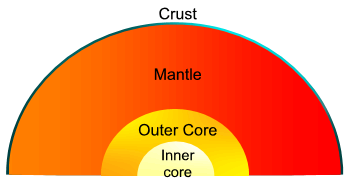
When a planet is made of rock, we call its surface the crust. Below the Earth's crust is hot molten rock. It is in a layer called the mantle. The hot molten rock is what comes out of volcanoes. It's then called lava.
Under the mantle is the core of the Earth. We think it is made from solid iron and nickel, surrounded by hot molten iron. The temperature there is very very hot!
The Earth's crust is very thin compared to the mantle and the core. But it is very thick to us. Nobody has drilled all the way through it yet.
How much does the Earth's gravity pull on me?
It's easy to find your weight on Earth by using a scale. You have weight because the Earth's gravity pulls you towards its center. Normally, the ground or the floor get in the way, making you feel 'stuck' to them.
There are several kinds of scales:
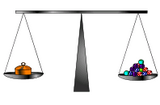
1) Comparing of 2 masses (weights). You put the thing(s) you want to weigh on one pan (like some marbles), and then you put several "weights" on the other pan until the pointer shows that both pans have equal weights on them. Then you look at the pan with the known weights on it, and add them all up. The total is the mass of the thing(s) you want to weigh.For a good interactive exercise comparing mass and weight see: What is the difference between mass and weight.

2) A spring balance usually has a hook on it, with a pan. You put the thing(s) you want to weigh on the pan, the spring is pulled, and the greater the weight, the further the spring is pulled. That distance, calibrated in pounds or kilogram (or whatever), is usually shown either on a dial or on a linear scale.
3) There are also electronic scales that give a properly calibrated reading—grocery stores, for example, use these.
NOTE: Gravity varies slightly depending on the location where you want to get the weight; spring balances and some electronic scales can, in theory, read slightly different weights at different places because of that, but usually in practice that difference it too small to be noticed. But, because the balance type of scales work differently to the spring or electronic types, they will always read the true, correct mass. The would even give the same mass on the Moon, where gravity is much less than on Earth.
Did you know? that Sir Isaac Newton was the first person to realise that the force pulling you down to the ground was the same force that keeps the planets going around the Sun? The story goes that he thought of this when he saw an apple fall from a tree.
Gravity is a very important force. As well as keeping you firmly stuck to the Earth, it keeps the Moon going round the Earth, The Earth going around the Sun and the Sun going around the center of the Milky Way galaxy. Gravity also makes stars and planets a nice round ball shape. In fact without gravity there wouldn't even be a Sun, Moon or Earth because the material that they are made of would just float away into space.
Who is it named after?
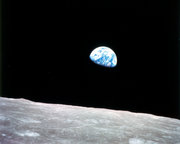
The word earth is used for both planet Earth and soil. Other names had been used for Earth such as Gaia and Tellus. Gaia is the Greek goddess (meaning Earth). Tellus is the Roman name of the same goddess.
 THE SYMBOL FOR EARTH
THE SYMBOL FOR EARTH
TEST YOUR KNOWLEDGE OF THE MATERIAL
1) A year on Earth is
Please enter your answer in the space provided:
3)What is distance between the oxygen atoms in a water dimer?
Solar System
- Table of Contents
- Introduction
- About the Solar System
- The Sun
- Mercury
- Venus
- Earth
- Moon
- Mars
- Asteroid belt
- Jupiter
- Saturn
- Uranus
- Neptune
- Pluto
- Comets
- Kuiper Belt
- Oort Cloud
- How the Solar System was born
- What will happen to the Solar System in the future
- Solar System/Space exploration
- Glossary
Beyond The Solar System
Earth Systems
- Layers of the Earth -- What are the different types of Seismic Waves
- What causes precipitation? What causes it to rain or snow? What causes dew on the ground?
- What is the Coriolis Effect?
- About gravity, mass, and weight
- What are seismic waves? What are the different types of seismic waves?
- What is Humidity? How is Humidity Measured?
- What causes precipitation --( rain or snow)?